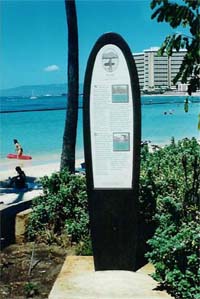 |

Trail Into Past of Waikiki Now Complete
The Honolulu Advertiser
July 2002
by James Gonser
The final marker in the Waikiki Historic Trail was installed recently, completing the project stared by Hawaiian historian George Kanahele, who died in 2000. The marker is part of the trail's free walking tours and takes curious visitors and kama'aina to 23 designate sites detailing the early days of Waikiki.
"Everybody is always surprised that Waikiki has a history," said Dorien McClellan, program director for the Native Hawaiian Hospitality Association, which runs the tours. "The perception is that there is Waikiki and the rest of Hawai'i."
The model for 6-foot-tall, surfboard-shaped markers were created by Holden Wood Design, who made the original out of redwood and then had it cast in bronze. The metal is given a patina so that the markers' material appears to resemble koa.
The markers cost about $12,000 each and include photographs, maps and information about the spot. The first marker was placed in 1998. The final marker is in a small triangle park shaded by a couple of dozen coconut tress at the corner of Beach Walk and Kalakaua Avenue. It was set in place on June 27 by architect Charles Palumbo and craftsman Lars Erickson. the duo have installed all 19 of the markers — four of the 23 designated sites do not have them — by digging a hole, pouring concrete and bolting down the surfboard.
"I fell in love with the project," Palumbo said. "There is a lot of history in Waikiki and a lot of magical places. This project has helped me understand more about the place I live. Once we mortared in the last marker, I really felt George was up there looking down at us and smiling.
Palumbo is credited with singlehandedly pushing forward Kanahele's idea for the trail and of "creating a Hawaiian sense of place in Waikiki." Over the years, Palumbo created the design for the markers, gathered the necessary city permits, raised money for the project, and finally installed each one.
The final site was once part of 10,000-tree coconut grove known as Helumoa and plated by Hawaiian chief Kakuhihewa in the 16th century. The site is also near where Kamehameha the Great camped wit his warriors as they began their conquest of O'ahu in 1795, according to the marker. Other sites include the residence of Queen Lili'uokalani, the Kapaemahu healing stones and 'Ainahau where Robert Louis Stevenson met Princess Ka'iulani.
McClellan said the personally guided tours are divided into two sections covering the east and west ends of Waikiki. Both tours begin at 9:00 am daily except SUnday. "About half the customers are residents and half visitors," she said, "It's great to mix them," McClellan said. "We are trying to get teachers to include this tour, particularly for the fourth grade when the students study Hawaiiana, as a regular field trip. Kids absolutely love it." Kaima'aina also respond to the tour with renewed pride in Waikiki, Mcclellan said, and visitors feel enriched.
"Residents feel they are reclaiming Waikiki as part of the home — that Waikiki is not a separate place that other people go to," she said. "They remember delightful days and reminisce about when the local community was always down there listening to music."
"Visitors pick up a cultural richness. I suppose you could call it education, but it is also very entertaining."WHAT: Free tours of points of historic interest
WHEN: 9:00 am daily except Sunday
WHERE: To take the Queen's Tour, look for the trail historian at the visitor information station at Kalakaua and Kapahulu Avenues. To take the Kailia tour, see the trail historian at the Bishop Museum's Kailia site in the Kailia Tower of Hilton Hawaiian Village.
CALL: For more information call 841-6422 or visit the web site at www.waikikihistoricaltrail.com |
|  |
